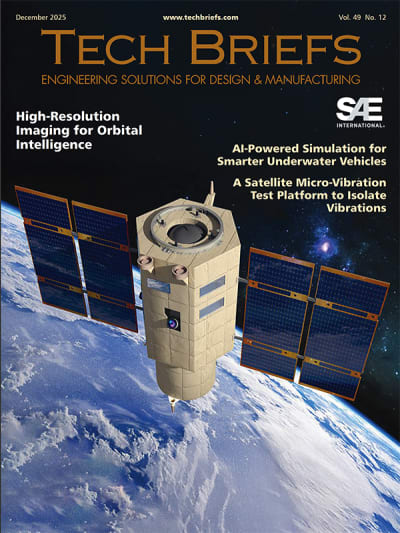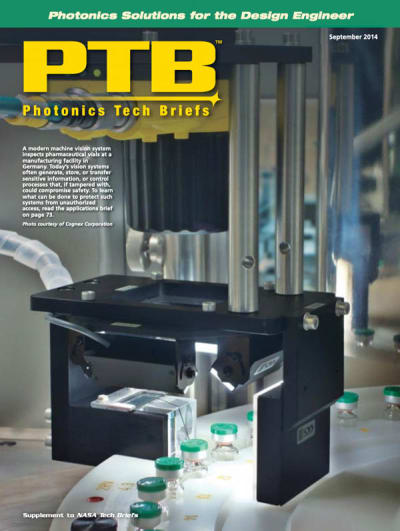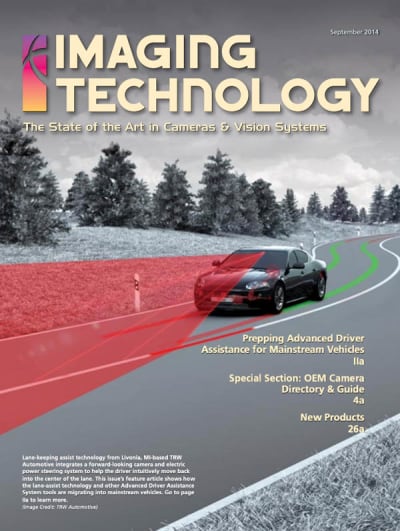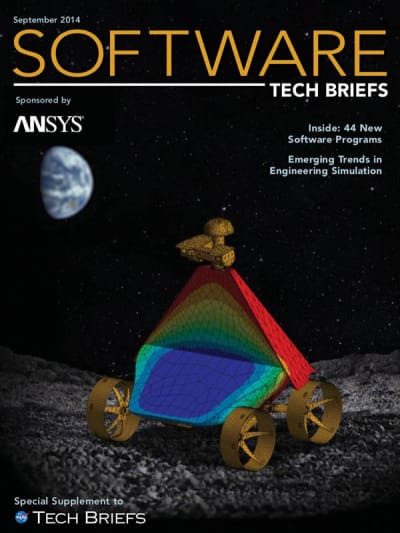Inside this issue
Overview
The September 2014 issue of NASA Tech Briefs features a diverse array of topics centered around advancements in technology, particularly in robotics, automation, and photonics. This edition serves as a valuable resource for engineers, designers, and industry professionals looking to stay informed about the latest innovations and applications in these fields.
Key Highlights:
-
Robotics and Automation: The issue opens with an exploration of how robots are becoming increasingly sophisticated, almost resembling humans in their capabilities. This trend is driven by advancements in artificial intelligence and machine learning, enabling robots to perform complex tasks with greater autonomy. The article discusses various applications of robotics in industries such as manufacturing, healthcare, and logistics, highlighting the potential for increased efficiency and safety.
-
Satellite Data Monitoring: Another significant feature is the use of satellite data to monitor the nation’s forests. This technology plays a crucial role in environmental conservation, allowing for real-time tracking of forest health, deforestation rates, and the impact of climate change. The article emphasizes the importance of satellite imagery in providing critical data for policymakers and conservationists, aiding in the development of strategies to protect natural resources.
-
Advanced Driver Assistance Systems (ADAS): A notable article focuses on the integration of lane-keeping assist technology in mainstream vehicles. Developed by TRW Automotive, this system combines a forward-looking camera with electric power steering to help drivers maintain their position within the lane. The article discusses the broader implications of ADAS technologies, which are becoming essential for enhancing vehicle safety and reducing accidents. It also highlights the ongoing evolution of these systems as they transition from luxury features to standard equipment in everyday vehicles.
-
Photonics and Imaging Technology: The issue includes a special section dedicated to photonics solutions for design engineers. Photonics, the science of light manipulation, is increasingly important in various applications, including telecommunications, medical devices, and manufacturing. The articles in this section provide insights into the latest developments in imaging technology, including advancements in sensors and optical systems that enhance performance and reliability.
Motion Control and Automation Technology: The magazine features a comprehensive guide on motion control technologies, which are critical for precision in automated systems. This section covers new products and innovations that improve the efficiency and accuracy of motion control applications. The guide serves as a valuable resource for engineers looking to implement cutting-edge solutions in their projects.
-
Special Supplements: This issue also includes special supplements such as the Motors Guide, which provides an overview of the latest motor technologies and their applications. The guide is designed to help engineers select the right motors for their specific needs, offering insights into performance characteristics, efficiency, and integration with other systems.
-
Technical Articles and Resources: Throughout the magazine, readers will find a variety of technical articles that delve into specific challenges and solutions in engineering and technology. These articles are complemented by resources such as downloadable software, manuals, and example programs, providing practical tools for professionals in the field.
-
Free Information and Resources: The magazine encourages readers to access additional free resources available online, including technical briefs, product reviews, and educational materials. These resources are designed to support ongoing learning and development in the rapidly evolving fields of technology and engineering.
Conclusion:
The September 2014 issue of NASA Tech Briefs is a rich compilation of articles and resources that reflect the current trends and innovations in robotics, automation, and photonics. It serves as an essential guide for professionals seeking to enhance their knowledge and stay competitive in their respective fields. With a focus on practical applications and cutting-edge technology, this issue is a must-read for anyone involved in engineering and design.
Overall, the magazine not only highlights the advancements in technology but also emphasizes the importance of collaboration between industries, researchers, and policymakers to drive innovation and address the challenges of the future.
Features
-
Application Briefs
NASA Uses Analysis Software to Assess Orion Crew Module Heat Shield
-
Who's Who
Scott Jensen, Aerospace Technologist (AST) Electronics Engineer, Stennis Space Center, Mississippi
-
Articles
Tech Briefs
-
Bio-Medical
Managing Post-Traumatic Pain With Ultrasound Neuromodulation
HeartBeatID – Heart Electrical Actions as Biometric Indicia
Cryogenic Grinding for Mechanical Abrasion for Hardy Endospores
Making Mesh Buckypaper Capsules for Transplantation of Cells and Implantation of Medical Devices
-
Physical Sciences
Photogrammetric Recession Measurement
Tissue-Equivalent Radiation Dosimeteron-a-Chip with Plastic Scintillation Material
Measurement of Cryogenic Fluid Level with Laser Propagation and Surface Floor Reflection
-
Manufacturing & Prototyping
Durable Joining Technology for Uniformly-Curved Composite Sandwich Structures
-
Materials
Toughened Uni-piece Fibrous Reinforced Oxidation-Resistant Composite (TUFROC)
High-Efficiency Tantalum-Based Ceramic Composite Structures
Use of Solvent-Free Conditions/Dry Mixing for Functionalizing Carbon Nanotubes
Synthesis of Novel Copoly(alkyl ether imide)s With Unique Surface Properties
Inkjet-Assisted Creation of Self-Healing Layers Between Composite Plies
-
Information Sciences
Non-Binary Protograph-Based LDPC Codes for Short Block Lengths
Method Resolves Algebraic Loops While Improving Accuracy and Reducing Runtime
-
Mechanics & Machinery
Universal Mechanical Testers for Tribology Testing in the Automotive Industry
Fail-Safe Accumulator for Internal Active Thermal Control Loops
Rocket Vent Design With Variable Flow Control and Rain Protection
Turbo-Brayton Converter for Fission Surface Power Applications
-
Electronics & Computers
Minimally Obstructed Communication via Acoustic Modems in Fluid-Filled Pipes
Biofeedback System for Optimal Athletic Performance
Methods for Clock and Reset Synchronization in a CMOS Integrated Circuit
Wideband MMIC Distributed Amplifier-Based Microwave Power Module
Communication Monitoring System for Enhanced Situational Awareness
Products
-
Briefs
Solar Pumped Fiber Laser for Solar Sail Propulsion and Remote Power Transfer
ELID Grinding of Large Aspheres
Systems and Methods for Localized Surface Plasmon Resonance Sensing
-
Applications
-
Articles
Selecting the Proper Motor for Linear Motion Applications
Design Considerations for Gearmotors in Long-Life Applications
Ring Motors - Design Flexibility for Innovative Configurations
-
Applications
-
Briefs
Designing Reliable Robots for Moon Exploration
Designing Smaller Magnets for the Large Hadron Collider
Electrical Calibration Source for Next-Generation Oscilloscope
Composite Sports Car Body Design
Simulation and Visualization of Elastodynamics in Time- Evolving Generalized Curvilinear Coordinates
3D Finite Element Model of Magnetic Mirror and Nano Antenna
Toolbox for Modeling and Analysis of Thermodynamic Systems (T-MATS)
Advanced Numerical Tools for Design and Analysis of In-Space Valve and Feed Systems
Method for Visualization of Analog Signals
Time-Multiplexed Pipelined FFT Implementation
Fully Configurable Interrupt Controller
Model of Radiation Effects on Electronics (MREE)
Development of an Analytical Parameterized Linear Lateral Dynamic Model for an Aerobot Airship
Algorithm Enhancements to Powered Descent Guidance Software
Using Describing Functions for Aeroservoelastic Models with Free-Play
Design Environment for Multi-Fidelity and Multi-Disciplinary Components
Shipping Foam Designer Software
Evolutionary Mission Trajectory Generator
Visual International Space Station Configuration Viewing Tool
Two-Equation Turbulence Models for Application to Internal Flow Through Pneumatic Valves
Multi-Species Turbulent Mixing Under Supercritical-Pressure Conditions
A Model of Reduced Oxidation Kinetics Using Constituents and Species
Determining Radiation Shielding Capability of the Earth’s Atmosphere from FAA Radiation Data
Integrated Space Weather Analysis System (iSWA)
Automatic Localization of MSL Rover Mosaics in HiRISE Imagery
SAM/MSL Terrestrial Background Spectral Library
Efficient Spectral Endmember Detection Onboard Spacecraft
Ray Tracing Model and Software for a Focused IR Lamp Heating System
PACIFIC: Process Algebra Capture of Intent from Information Content
Quantification of Trace Chemicals Using the Vehicle Cabin Atmosphere Monitor
Improved Math Model for Multiphoto Measurement Systems
Multipurpose Attitude and Pointing System (MAPS) Version 6.2
Global Elevation Data Adaptive Compression Algorithms
Cassini Science Planning and Sequencing Team Final Sequence Approval Document Generator (Autodoc)
Exploration Visualization Environment
Mississippi Evacuation and Traveler’s Assistance (MSETA) Software
Cloud Computing for Science Data Processing in Support of Emergency Response






